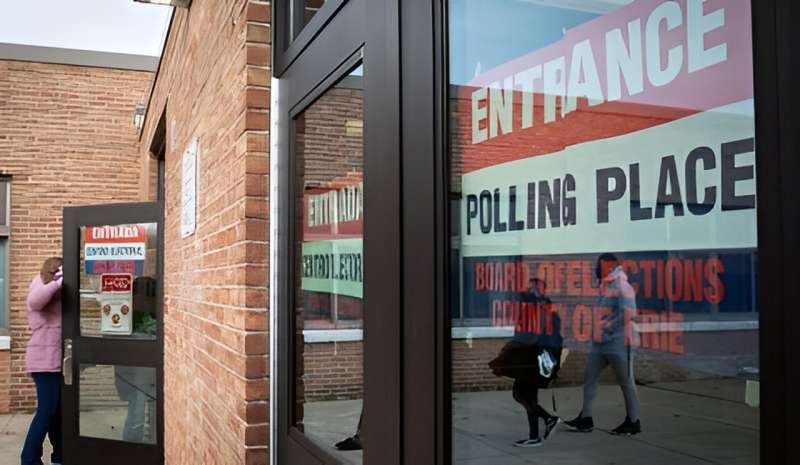This article has been reviewed according to Science X's editorial process and policies. Editors have highlighted the following attributes while ensuring the content's credibility:
fact-checked
peer-reviewed publication
trusted source
proofread
Compulsory voting can reduce political polarization in the US, study finds

Introducing compulsory voting in the United States and other majoritarian democracies, with meaningful and enforceable penalties for abstention, has the potential to reduce political polarization and protect democratic institutions from anti-democratic threats, according to a paper published by a University at Buffalo political philosopher.
The findings, published in the journal American Political Science Review involve the novel repurposing of existing theoretical political models to show how a compulsory voting system could reduce the distance between the proposed policies of two major political parties.
"One reason for political polarization is that candidates have to cater to their parties' extremists, who threaten to not turn out unless their demands are met. Compulsory voting could push party platforms toward the center by reducing extremists' ability to make these kinds of threats. This would directly decrease polarization," says Alexandra Oprea, Ph.D., an assistant professor of philosophy in UB's Philosophy, Politics and Economics program, and the paper's first author.
"We need to be creative and consider options for increasing turnout because the harms caused by political polarization are severe for democracy," Oprea says.
Voting, often called a citizen's "duty," has remained largely voluntary since the beginning of Athenian democracy. But that has started to change, as many democracies have installed, experimented or proposed compulsory voting systems.
There are currently 27 countries worldwide with compulsory voting in place including Australia, Belgium and Peru. Another 12 countries have experimented with such a system. Canada, the United Kingdom and France recently introduced compulsory voting bills that failed to gain support.
In the U.S., former President Barack Obama endorsed a form of compulsory voting as a short-term solution to increasing turnout among young people and individuals from low socioeconomic backgrounds and underrepresented groups. And there is a bill under consideration in Washington that would make voting compulsory in that state.
Compulsory voting refers to policies mandating turnout (voters can refuse to cast a valid ballot once at the polls) for a range of national and subnational elections. Some compulsory voting systems are unenforced, while others carry fines of roughly $20 U.S. for abstaining. Empirical studies of compulsory voting suggest turnout increases ranging from 7 to 10 percentage points with no enforcement, to anywhere from 14.5 to 18.5 percentage points with enforcement.
"The main idea is not that compulsory voting brings turnout to 100%. But adding 10 to 20% turnout to an election—especially midterm elections in the U.S. that have particularly low turnout—completely changes the political game. Even 5% to 10% would make a significant difference," says Oprea.
Oprea's paper began by discussing the absence of extreme polarization in Australia with co-author Geoffrey Brennan, Ph.D., professor of philosophy at the Australian National University (who passed away before the paper was published), and Lucy Martin, Ph.D., associate professor of political science at the University of North Carolina at Chapel Hill. They adapted a theoretical model for voter abstention and discussed how it predicts that compulsory voting would increase turnout.
The paper runs theoretical simulations using three baseline levels of turnout (40%, 50% and 60%) that cover the range of turnouts seen in U.S. congressional and presidential elections over the past two decades. Assuming a turnout increase of 16.5 percentage points (the middle of empirical estimates), even the worst-case scenario suggests a meaningful 22% decline in polarization.
Implementing compulsory voting in the U.S., however, is not likely, according to Oprea, who says such a proposal would bring constitutional challenges, and getting every state on board would be difficult.
But she believes it's time for local and state governments to experiment with ways to increase turnout.
"We've experimented with ranked choice voting, where voters rank candidates according to preference, and other experiments at the municipal level," she says. "Our paper suggests compulsory voting would be worth trying, so long as governments can do it legally.
"Doing so would show proof of what it can accomplish."
More information: Alexandra Oprea et al, Moving toward the Median: Compulsory Voting and Political Polarization, American Political Science Review (2024). DOI: 10.1017/S0003055423001399
Journal information: American Political Science Review
Provided by University at Buffalo





















